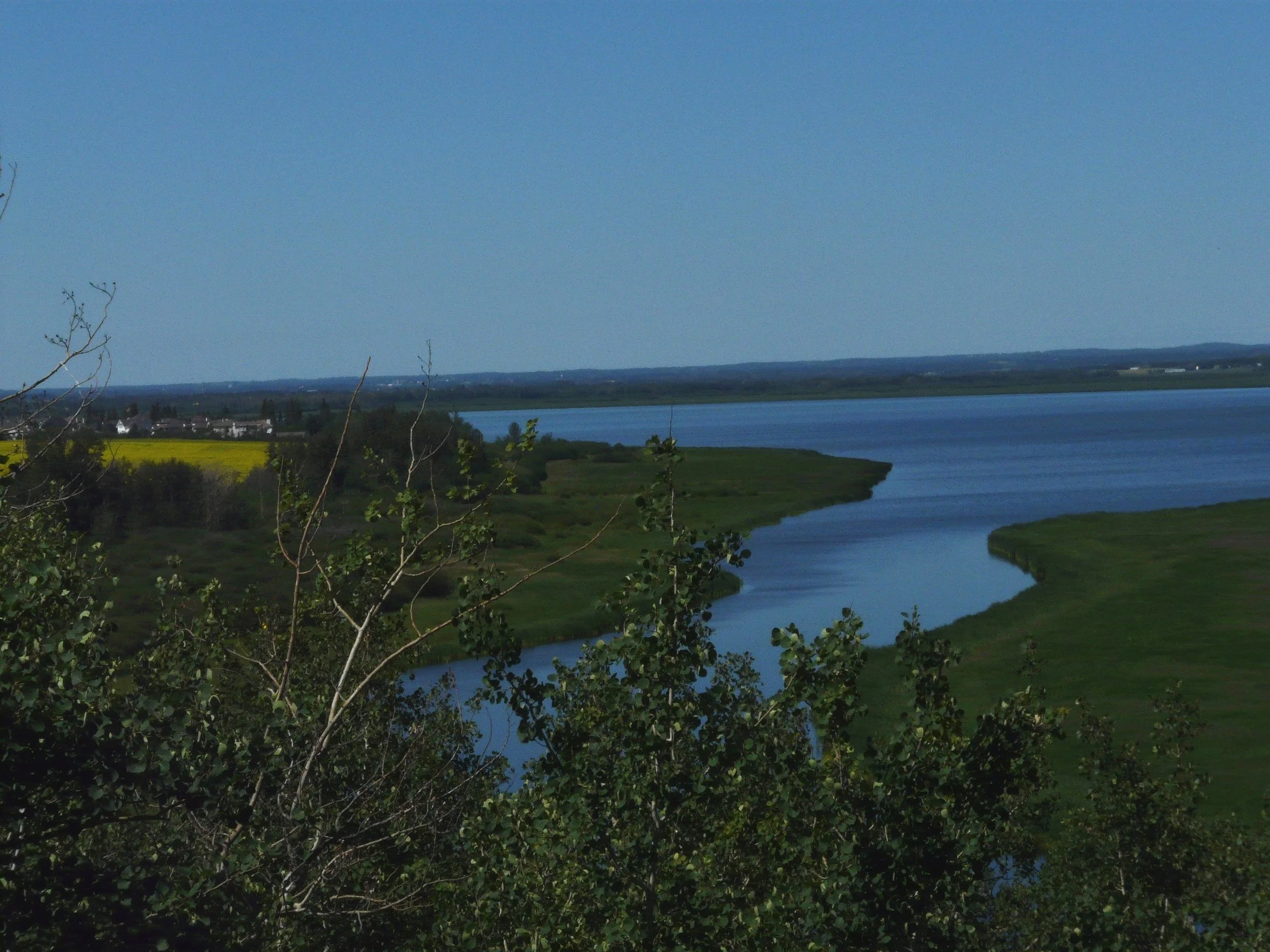BIG LAKE AND THE STURGEON RIVER
Big Lake, a relatively little known jewel of the capital region, abuts the northwest corner of Edmonton and the southwest corner of St. Albert. Parkland County borders the lake on the south and Sturgeon County on the north.
The view from the south shore at “the Narrows” is panoramic, here the east bay is laid out looking north west.
Big Lake sits on the sands and gravels of the Empress Formation, an aquifer 30 meters below its surface that was laid down by retreating glacial meltwaters.
Centred at 53°36'N, 113°43'W, Big Lake is part of the 260 km long Sturgeon River that begins at Hoople Lake and flows east to the North Saskatchewan River. Atim Creek flows into Big Lake from the west and Carrot Creek from the north.
Big Lake is about 8 km in length and 3 km at its widest point. At the delta, one of only three birdsfoot deltas to be found in Alberta, the lake narrows to 100m. The lake is shallow, with depths varying between 0.3 to 4.1 m. Banks along the southern shore are steep, directing the lake’s flood waters towards the west, north and east to feed surrounding marshlands during high water years.
Old stands of white spruce grow on the northeast shore of the lake and a deciduous forest on the south contain highly diverse vegetation with unusual and rare plant species that include orchids and ferns.
More than 235 bird species have been recorded at Big Lake, some 180 are recorded annually. At risk species that use the lake include Trumpeter Swans, Sprague's Pipits and Peregrine Falcons.
The western bay of the lake provides rare nesting habitat for Franklin's Gulls, a species that builds floating nests anchored to vegetation growing in shallow water. Known to have one of the longest migration routes, Franklin's gulls fly south as far as southern Peru and northern Chile every year. In 1983, Alberta Fish and Wildlife researchers noted two Franklin's gulls colonies in the west bay of Big Lake that together comprised between 2,000 and 3,000 individuals.
In the fall the lake is a staging area for Tundra Swans and Pelicans. Fall populations of swans have been as high as 20,000. Cormorants, Loons, Great Blue Herons and Ospreys fish the lake. Lesser Yellowlegs, Dowitchers, American Avocets and Sandpipers reside during low water years. In 2005 a family of Great Egrets nested at Big Lake for the first time and raised four youngsters.
Fish species found in the lake include Northern Pike, Goldeye, White Sucker, Walleye and Sticklebacks.
The lands surrounding Big Lake provide important habitat for Moose, White-tailed Deer, Beaver, Muskrat, Mink, Skunk, Coyote, Red Fox, Porcupine, Snowshoe Hare and Red Squirrel.
Archaeologists believe nomadic peoples used Big Lake as far back as 9,000 years. Specific archaeological sites have been recorded dating back 5,000 years. Stone tools and weapons found on the south and east sides of the lake attest to the importance of the lake to prehistoric people. Settlers from the St. Albert Mission, founded in 1861, hunted waterfowl on the lake and moose and deer along its shores, fished its waters and trapped beaver and muskrat from the wetlands. The lake and river provided drinking water to St. Albert residents well into the 1900s.
Alberta Fish and Wildlife considers Big Lake to be one of the 20 most important habitat areas in Alberta. In May 1999, the Alberta Government created the Big Lake Natural Area comprising 1,119 hectares of lake and wetlands. The lake was declared a "Special Places 2000" site and on June 5, 2001 became an Important Bird Areas site. It has been designated a "Wetlands for Tomorrow" by Ducks Unlimited Canada. On Earthday 2005, the Alberta government made Big Lake the province's newest Provincial Park, named Lois Hole Centennial Provincial Park in honour of the late Lieutenant Governor of Alberta. (ON THE CREATION OF LOIS HOLE PROVINCIAL PARK by Louise Horstman).
In 2024 LHCPP was expanded by 238 hectares, read the announcement here.
Many marvels of nature entice visitors, both human and otherwise to Big Lake. Feel free to contact BLESS if you have questions or would like more information. We would love to hear from you.

